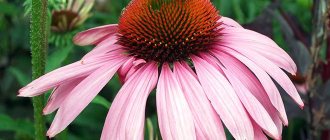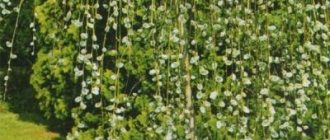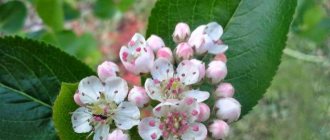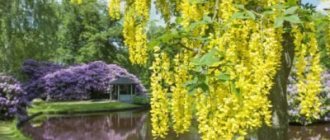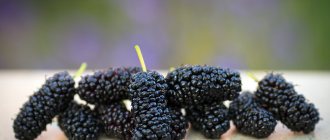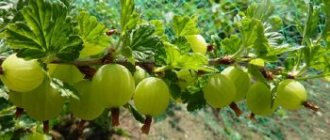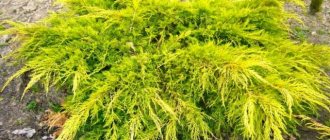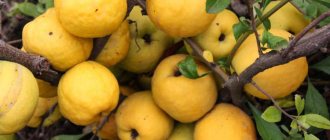Description of lingonberries
There are legends about a small evergreen shrub strewn with bright red beaded berries, pleasing the eye in the dreary autumn season. One of them talks about a swallow, which, having obtained drops of living water, was in a hurry to bring them to people in order to bestow immortality. But her plans were upset by an evil wasp that stung the bird. The swallow spilled priceless moisture on the ground, and it fell on the cedar, pine and lingonberries growing under them. From that moment on, these plants became the embodiment of eternal life, because they do not lose their green attire either in winter or in summer.
Lingonberries, which do not lose their green leaves all year round, have become the personification of eternal life.
Lingonberry is a resident of harsh regions. Its habitats extend across the tundra zone, mixed, coniferous and deciduous forests, peat bogs; it is found on the treeless peaks of the Siberian hills and in alpine meadows.
The lingonberry bush is tiny, its raised branched shoots grow from 5 to 25 cm. The rhizome is thin, horizontally located, creeping. The leaves are arranged alternately, often. Their length is from 0.5 to 3 cm, width is only 1.5 cm. The surface is leathery, dark green and shiny above, matte and lighter below. The shape of the leaf blade is obovate or elliptical, the edges are entire, curved. A special feature of the plant is the club-shaped formations located on the underside of the leaf that can absorb moisture.

Lingonberry is a miniature plant
Lingonberry is a striking example of the symbiosis of a plant and a fungus. Thread-like mycelium entwines the roots of the berry plant. The fungus extracts useful substances from the soil and transfers them to lingonberries. Therefore, there is no need to remove white plaque from the roots of the plant.
Flowering occurs in May - June. During this period, a subtle aroma is felt over the lingonberry meadow. 10 or 20 flowers, the corollas of which are painted porcelain white or pale pink, sit on short stalks. The entire bouquet is collected in a drooping brush. The bell-like flowers look very beautiful against the background of shiny greenery.
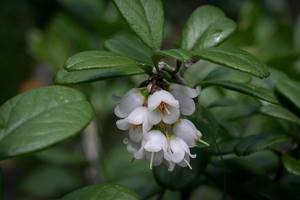
Small, porcelain-white lingonberry flowers are collected in bunches of flowers
Lingonberry fruits are shaped like a ball up to 8 mm in diameter. Ripe berries are covered with a shiny red skin, and at the beginning of ripening they are greenish-white. The pulp contains a large number of red-brown, very small seeds. The taste of lingonberries is sweet and sour, with a slight bitterness, juicy.
After surviving the first frost, lingonberries become soft and watery. They are no longer suitable for transportation in this form. Under the snow they can hang on branches until spring, but with the onset of warmth they fall off at the slightest touch.
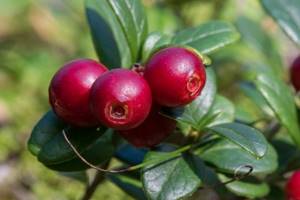
Lingonberry fruits are shaped like a ball
Lingonberries have been used as a medicine since ancient times. The raw materials are leaves and berries. Lingonberries are very popular in the treatment of kidneys as a diuretic, helps in the fight against gout, rheumatism, and reduces blood sugar levels. Lingonberries are also used in cosmetology. A decoction of the leaves helps get rid of dandruff, helps restore skin tone, strengthens it and restores elasticity.
Plant cultivation first began in the 18th century. But truly mass cultivation on an industrial scale was undertaken only in 1960 in the USA and Europe. And in Russia, the first plantations appeared in the 80s. The only pity is that healthy berries are a very rare guest in garden plots. But breeders have done painstaking work to create new varieties of lingonberries, which, unlike their wild ancestor, have large berries with high taste and bear fruit more productively.

In the USA and Europe, lingonberries have been grown on an industrial scale since 1960.
Ability to eliminate pigment spots on the skin
This ability of lingonberries is due to the same component - arbutin - which provides a diuretic effect. It has been proven that when this substance enters skin cells, it disrupts the synthesis of melanin and prevents the formation of age spots on the skin. Due to this, crushed lingonberries are sometimes added to various face masks, and juice from it is sometimes added to homemade lotions. Isolated arbutin is used in products produced by large concerns.

At the same time, arbutin is considered a source of increased carcinogenic danger. Studies have been conducted that have shown that its derivative - hydroquinone (which, in fact, has all the therapeutic and cosmetic effects) - is quite toxic, and in conjunction with other undesirable factors (for example, increased ultraviolet irradiation) can cause the development of oncology.
For this reason, today dihydroquercetin is more often used as a folk remedy to combat age spots - a less toxic remedy, the natural sources of which are milk thistle seeds, some conifers and individual fruits.
Face masks

Masks can rejuvenate the skin and tighten it. Recipe (course – 8 procedures):
- take 1 tbsp. l. chopped lingonberries;
- 1 tbsp. l. wheat flour;
- 1 tbsp. l. grapefruit;
- mix and apply to the skin around the perimeter;
- After 10 minutes, rinse with cool water.
Acne mask:
- mix lingonberry juice and mineral water (highly carbonated);
- wash with a healthy mask.
When the bubbles burst, they accelerate blood circulation, expanding the pores into which beneficial substances from lingonberries penetrate.
And to make a facial lotion, you need to mix equal amounts of juice from lingonberries, apples and grapefruits. The product produces an excellent moisturizing and cleansing effect.
Recipe for protein-lingonberry mask for oily skin
To reduce sebum secretion and tighten pores, a mask of berries and egg whites will help. It perfectly normalizes the functioning of the sebaceous glands and has a drying effect. The mask is suitable for the prevention of juvenile acne.
To obtain the composition of the mask, you need to take: 2 large spoons of lingonberry pulp and the white of one egg. Beat everything with a blender or whisk until smooth.
Apply for 20 minutes, then rinse off.
Nourishing mask recipe for dry skin
To properly moisturize and saturate your facial skin with nutrients you will need:
- Lingonberry pulp (1 large spoon)
- Sour cream (1 teaspoon)
- Olive oil (1 teaspoon)
After thorough mixing, apply the composition to the skin of the face and décolleté. After 15 - 20 minutes, rinse with slightly warm, then cool water.
Anti-wrinkle mask recipe for normal and combination skin
Masks with lingonberry juice have a rejuvenating effect. For this purpose, it is best to use fresh or thawed berries. 1 large spoon of gruel is mixed with 1 large spoon of grapefruit pulp gruel and 1 large spoon of wheat flour. Apply to face and neck for 10-15 minutes. It is better to rinse off with clean cool water.
Recipe for lingonberry mask for spider veins (rosacea)
Lingonberry mask for spider veins (rosacea):

- The mashed pulp is mixed with starch in equal parts.
- Use the mixture to carefully treat problem areas.
- Leave on skin for up to 15 minutes.
- Wash off with warm water.
The starch in the composition can be replaced with pollen, and the pulp of the fruit with lingonberry juice or water. It is important not to apply the mixture all over your face and apply the treatment no more than once a week.
With increased oily scalp, hair loss, and dandruff, an infusion of lingonberry leaves, used as a rinse after each wash, helps. The procedure relieves inflammation, nourishes and awakens the bulbs. For 1 liter of boiling water, it is enough to add 50 g of dry raw materials and leave until it cools completely.
Lingonberry leaves for hair
A decoction of the leaves removes dandruff and strengthens hair. It makes them soft, voluminous and beautiful. In addition to the fact that berries are useful to consume in any form for healthy hair, a decoction is also made from the leaves. It is enough for them to rinse clean hair.
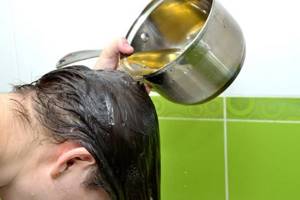
The procedure is performed no more than 2 times. in Week.
Recipes:
1. When treating dandruff or itchy scalp, infusions of lingonberry leaves are best. To prepare the required infusion:
- Crushed dry lingonberry leaves (1 large spoon)
- Water (1 glass)
Brew the leaves with boiling water and leave until cool. The resulting composition is used instead of rinse aid and balm after each wash for at least 2 months. For long hair, more composition will be required.
2. Scrub to cleanse the scalp and enhance hair growth:
- 1 tbsp. l. dried lingonberries, oat flakes and thyme herb are crushed in a coffee grinder and mixed.
- Massage the scalp with a dry scrub and leave for 5 minutes.
- Wash off with warm water.
To achieve the effect, you can massage with lingonberry flour up to 3 times a week. Hair growth is noticeably accelerated, dandruff is cured. The scrub can replace washing with shampoo. It perfectly cleanses the skin and hair and can be used every other time with conventional products.
3. Lingonberry mask that can stop hair loss:
- Grind carrots (1 pc.) in a blender or grate on a fine grater.
- Add 1/3 cup of lingonberry juice to the mixture.
- Add 2 tbsp. l. castor oil.
- Knead the mixture and apply to the scalp.
- Cover your hair with film and wrap it in a towel.
Leave this mask on the scalp for up to 2 hours, rinse with warm water and regular shampoo. Use the product up to two times a week. When the hair loss stops, repeat the treatment every 7 days to maintain healthy skin and beautiful hair.
Popular domestic and foreign varieties of lingonberries
Garden lingonberries differ from wild lingonberries in a number of positive characteristics, one of which is remontantity - the ability to bloom and bear fruit repeatedly or repeatedly during one growing season. In addition, the size and, accordingly, the weight of the berry of a cultivated plant is much larger than that of a forest dweller. And if we take the yield indicator, then cultivated plants from 1 acre produce 20, and sometimes 30 times more berries than ordinary ones.
Table: domestic varieties of lingonberries
| Variety | Description |
| Kostromichka | Ripens early. The plant is vigorous. In a fruit cluster you can count from 5 to 8 round berries with an average weight of 0.28 g. The dark red berries have no aroma, the taste is sweet and sour, refreshing. The variety can easily tolerate winter temperatures down to −33°C under snow cover. In snowless winters it can withstand −15°C. No pest damage was noted. Leaf rust damage is very mild. The average yield is 56.4 c/ha. |
| Ruby | Ripens late. The plant is medium-sized. The shape of the berries is round, the average weight is 0.22 g. The sweet and sour taste of dark red berries is rated 4.2 points. It is resistant to low temperatures, tolerates frosts down to −33°C if it is under snow. The variety can withstand spring frosts down to −3°C. It is extremely rarely affected by rust; no pests are observed. The average yield for 4 years is 97.2 c/ha. |
| Kostroma pink | Ripens in medium terms. The plant is slightly spreading and medium-sized. The cluster contains 4–5 round berries with an average weight of 0.46 g. The skin is pink. The taste is sweet and sour, refreshing. There is no aroma. Under snow it can withstand frosts down to −33°C, without snow cover it is half as much. Slightly damaged by rust. Productivity 38.4 c/ha. |
Photo gallery: domestic varieties of lingonberries
Kostromichka - an early variety in terms of ripening Rubin - a late variety of lingonberries

Kostroma pink - medium ripening variety
Table: foreign varieties of lingonberries
| Variety | Description |
| Sanna | The harvest is harvested early. The plant is medium-sized, decomposed. The cluster consists of 5–6 berries of a regular round shape, the average weight of one fruit is 0.4 g. The fleshy, sweet and sour pulp with a slight lemon flavor is covered with a coral-red skin. The variety tolerates frost well and has strong immunity. The only negative is insufficient yield. It is possible to collect no more than 300 g of fruit from one bush. |
| Coral | The plant is tall, characterized by long, erect shoots and a dense crown. The fruits average weight from 0.3 to 0.5 g, collected in clusters of 4–5 pieces. The shape of the berries is slightly obovate. The color of the fruit ranges from pink to bright red. The pulp tastes sweet and sour. The variety tolerates frost very well. Coral bears fruit twice during the growing season - at the end of June and at the end of September. The overall yield is high. But it is the autumn harvest that accounts for almost 90% of the total harvest. |
| Red Pearl | The harvest ripens early. Above average size, the bush has a wide and spreading crown. The fruits are burgundy in color, have a round shape and are quite large - from 7 to 12 mm in diameter. The pulp tastes sweet and sour, with a slight bitterness. The variety bears fruit twice a season. |
| Erntzegen | The plant is tall - up to 40 cm in height. Ripens in medium terms. The berries of the variety are considered the largest, reaching 1 or 1.5 cm in diameter. The skin has a light red tint. The pulp contains a large amount of sugars, so the taste is dominated by sweetness. The disadvantage of this variety is its low yield - only 200 g per bush. |
| Sussi | Quite a low-growing variety. The crown is decomposed and branched. The fruit cluster consists of 5–6 coral-red round berries. The average weight of the fruit is 0.4 g. The flavor range contains sweet and sour notes, to which a slight bitterness is added. Sussi has good frost resistance. The yield is 300–400 g per bush. |
| Fleece Belyavskoe | An early variety, small in size. Bushes are spherical in shape. The mass of oval or slightly flattened berries is 28–35 g. The fruits are covered in a thin, shiny, dark red skin. The taste is soft, sweetness predominates. The sourness is barely perceptible. Lingonberries of this variety tolerate snowy winters well, but require shelter during the snowless period. From one bush you can collect up to 350 g of berries. |
| Mazovia | The bushes are miniature and decorative. Berries weighing 0.25 g have an average ripening period. The fruits are round in shape and covered with dark red skin. The pulp tastes sweet and sour. The yield is low - up to 40 g per bush. But the variety is an excellent material for landscape design. |
Photo gallery: foreign varieties of lingonberries
Sanna is an early ripening lingonberry variety.
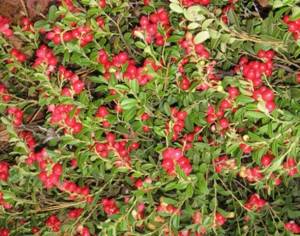
Lingonberry variety Coral bears fruit twice a year

Red pearl lingonberry variety ripens early
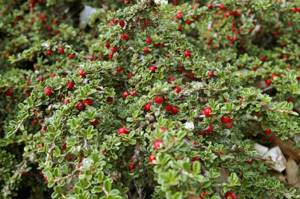
The lingonberry variety Erntzegen is medium in terms of ripening period. The lingonberry bushes of the Sussi variety are rather short-growing
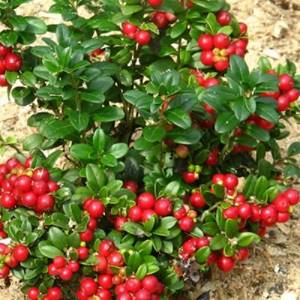
Lingonberry variety Runo Belyavskoe - early ripening

Mazovia is a medium-ripening variety
Agricultural technology for growing lingonberries
Growing lingonberries at home is not at all difficult. You just need to adhere to certain rules.
Landing
If you decide to plant lingonberries on your site, you should consider the following nuances:
- for planting, use young - one- or two-year-old - plants;
- Lingonberries do not like heavily fertilized soils;
- only loose and acidic soils with a pH of 3–4.5 have favorable conditions for plant growth and development;
- it is advisable to prepare the soil yourself, making sure to include high-moor peat, coarse sand, pine litter and pine bark;
- the soil in which lingonberries grow needs to be periodically acidified;
- The planting site should be level, well lit and slightly blown by the wind, especially after rain or watering, so that excessive evaporation does not provoke fungal diseases. The ideal option would be to place lingonberries next to a hedge of pine or juniper. Such natural protection from strong winds will contribute to the active work of pollinating insects;
- The groundwater level should be 60 cm below the surface.
Planting pattern:
- distance between bushes - 25–30 cm;
- row spacing - up to 40 cm;
- planting depth - 10–15 cm.
Video: planting lingonberries and blueberries
Watering, loosening and mulching
First you need to know that lingonberries have a superficial root system, which dries out very quickly in loose soil. Therefore, it is necessary to maintain soil moisture at a very high level - at least 70%. This can be achieved by watering at least once a week. During particularly hot periods, watering should be done more often: up to 2-3 times in 7 days. But at the same time, frequent waterlogging or flooding of lingonberry plantings can cut off the access of oxygen to the roots, which will immediately affect the health of the plant.
During the ripening of the second wave of crops on remontant varieties, flower buds of the future harvest are being laid. And it is during this period that lingonberries most need watering.
The best method of moistening for lingonberries is sprinkling, but provided that the area is well ventilated. It should be done only early in the morning or in the evening so that the wet leaves are not damaged by the sun. In addition to sprinkling, you can use drip irrigation. The water consumption rate per 1 m2 is no more than 10 liters.
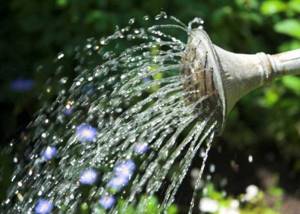
If the area where lingonberries grow is well ventilated, then the plant will like sprinkling.
Plantings require frequent but careful loosening to get rid of weeds. But digging cannot be done. Also, be sure to use mulch to help retain adequate moisture. Use coarse sand or fine gravel as mulch on peaty soils. For sandy ones, the best choice is pine sawdust and needles, peat.
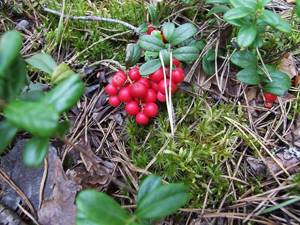
Lingonberry bushes must be mulched
Fertilizing lingonberries
As already mentioned, lingonberries do not like rich soils. Therefore, when fertilizing the plant, do not get carried away. The rule here is that it is better to underfeed than to overfeed. Too much nutrients can lead to reduced yield, leaf shedding and stunted growth.
Everyone's favorite organic matter in the form of manure or bird droppings is not suitable for lingonberries. It contains high levels of nitrogen, which can burn sensitive roots. In addition, organic matter alkalizes the soil, which leads to chlorosis and then to the death of the plant. Potassium chloride is also contraindicated.
Fertilizing lingonberries should be done no earlier than 3 years after planting, when the berry begins to bear fruit. When choosing fertilizers, give preference to mineral compounds. For nitrogen supplementation, choose urea, ammonium nitrate or ammonium sulfate. You also cannot do without potassium sulfate and superphosphate. Plants growing on peat soils require manganese, boron, zinc and copper.
Mineral fertilizers are applied only in liquid form to pre-moistened plantings.
Recent Entries
5 working ways to use tar in the garden 7 indoor plants that help you get married even in adulthood Indoor plants that can bloom in trouble
Table: fertilization
| Period | Type and rate of fertilizer per 1 m2 |
| In mid-April, when the growing season begins |
|
| Before flowering | Ammonium sulfate - 5 g. |
| After harvest |
Instead of the listed fertilizers, you can use complex fertilizers, for example, Kemira or Kemira Universal.
Experienced gardeners, instead of fertilizers, regularly apply high-moor peat, distributing it over the surface of the soil in the plantings.
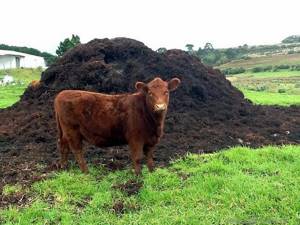
Unfortunately, organic fertilizers are not suitable for lingonberries.
Treatment of lingonberries from diseases and pests
Lingonberries have strong immunity and are resistant to many types of diseases and pests. But with excess humidity combined with elevated air temperatures, fungal infections are possible.
- Exobasidiosis. The disease affects shoots, leaves and flowers. In addition to deformation of the leaves, a change in their color is a symptom. The leaf blade turns pink and a whitish coating of fungal spores appears on it. To stop the spread of the disease, Bordeaux mixture is used. Spraying is carried out 3-4 times at weekly intervals. Affected plants will have to be cut out and burned.
- Sclerotonia. The fruits are the first to be affected. They shrink and mummify. The disease is fought with Bordeaux mixture in the spring, before the leaves bloom, and in the fall, after they fall. Carry out 2-3 treatments. You can use a 0.2% solution of Zuparen - 3 sprays at intervals of a week before flowering and the same amount after harvesting. Pick up and destroy fallen diseased berries.
- Rust. The leaves are covered with dark orange spots. To cope with the disease, 2-3 treatments with Bordeaux mixture are carried out before the leaves bloom and after they fall off. Collect and burn all fallen affected leaves.
Cases of pest damage are rare, and no noticeable damage is caused to plant growth and harvest. Among the insects, leaf-eating insects have been spotted - hornworm caterpillars, leaf beetles, and leaf rollers. As a rule, at the beginning of discovery they are collected by hand. Lingonberries can also be attacked by aphids and scale insects. They are fought with insecticides, in accordance with the instructions and only if absolutely necessary.
Photo gallery: possible diseases and pests
Leaves suffer from exobasidiosis, they change color and become covered with a fungal coating.

Sclerotonia affects fruits
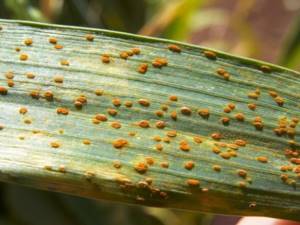
Rust appears on the leaves as orange pads.

The hornworm caterpillar is dangerous not only for plants, its hairs can cause severe allergies in humans or animals
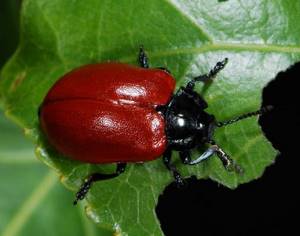
Leaf beetle nibbles leaves
Trimming
This procedure is carried out to rejuvenate the plantings when the lingonberries are 7–10 years old. By removing most of the old shoots, you keep the bushes productive. The plantings themselves become more durable.
Pruning can be carried out throughout the growing season. But the best time is still early spring, when the movement of juices has not yet begun. Long shoots are shortened by a third, and old ones are cut out.
In this case, there must be several branches left on the bush. And the cuttings obtained after pruning will serve as excellent planting material and help expand the plantation.
Rules for caring for shrubs
- Avoid overwatering.
- Clear the soil of weeds during the warm season.
- Thin out dense young growth using pruning shears.
- If during lingonberry flowering the temperature drops below -3 °C, it should be covered with spunbond or agril.
- The soil around lingonberries needs to be loosened in the summer season.
Watering and soil care
It is best to use drip irrigation or irrigate it by hand twice a week. The main thing is to maintain the “golden mean” between drying out and waterlogging.
Red clover medicinal properties and contraindications for menopause
Water reduces the acidity of the soil over time, so you can organize acidification of the soil every three weeks. Growing lingonberries also requires soil care. It needs to be loosened in a timely manner, weeds removed, and mulched periodically.
Fertilizer
Mineral fertilizers are applied in small quantities during the fruiting period - 1 tbsp. spoon per 10 sq. m . It is best to organize fertilizing in spring or early summer.
For this you can use superphosphate 30 g/m2. m, ammonium nitrate (30-40 g per 10 liters of water). Special preparations for heathers are also used, such as Mortar and Kemira.
Important! You cannot apply mineral fertilizers to the soil with lingonberries immediately after planting, because they inhibit the formation of roots.
Trimming
When the lingonberry bush reaches seven years of age, it undergoes anti-aging pruning, leaving a shoot 4 cm long. It will begin to bear fruit again within a year. Pruning should be done in early spring, when the movement of juices in the plants has not yet begun.
Cowberry propagation
It's easy to propagate lingonberries. There are as many as 4 available methods - 3 vegetative and 1 seed, each of which will be considered separately.
Propagation by stem cuttings
- In early spring, before the start of sap flow, or in late autumn, cuttings of at least 5 cm in length are cut using pruning shears.
- A soil mixture is prepared from 2 parts peat and 1 part sand. The mixed soil is poured into containers and moistened.
- Before planting, the cuttings are soaked for several hours in a solution of a growth stimulator (you can do without this).
- The lower cut of the cuttings is immersed in the substrate, leaving at least 2–3 buds above the surface.
- To maintain high humidity, containers with cuttings are covered with a bag, creating a greenhouse microclimate inside with an air temperature of +25°C.
- The plantings are periodically ventilated and sprinkled with water.
- During the growing season, the cuttings acquire a root system. The following year they are safely relocated to a permanent place.
Video: how to properly cut lingonberries
Propagation by root cuttings
The procedure is carried out only if the area of the rhizome has growth buds or shoots. This lingonberry propagation method is suitable for late April or early May.
- In order for rooting to be successful, prepare a bed, which is filled with a substrate of sand and peat in proportions 1:3 or 1:2.
- Ten-centimeter depressions are made in the substrate and the surface is moistened.
- Pieces of rhizome are planted, covered with soil and watered again.
- Wire arches must be installed above the bed and the plantings covered with covering material.
- Water for a month, preventing the substrate from drying out. After rooting, the cover can be removed, but watering must be done regularly. Young plants, which will get stronger by the end of the growing season, are left to overwinter in the garden bed.
- Lingonberries grown from root cuttings will be ready for transplanting to a permanent location in a year or two.
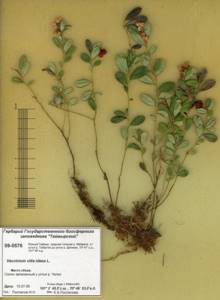
A rhizome with shoots can be divided into parts
Reproduction by partial, or daughter bushes
From the underground rhizomatous shoots - stolons - formed in lingonberries, young plants are formed. They are connected to the mother plant by rhizomes and are called partial bushes. For the purpose of propagation, only bushes that have their own root system are used. Reproduction in this way is possible both in spring and autumn. To do this, young and well-formed bushes are dug up and separated from the mother plant.
- You can plant lingonberry bushes either in a prepared separate bed for growing, or in separate containers.
- Plants grown in containers are ready for transplanting into open ground after a year.
- It is best to plant bushes in the garden bed for further growing in the spring. The plant will have enough time to take root before winter.
- Bushes planted in autumn should be well mulched with peat, spruce branches, or a shelter made of non-woven material should be installed over them.
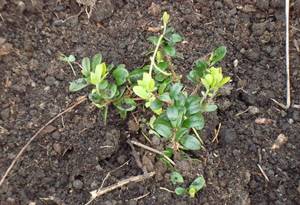
Partial lingonberry bushes can be planted in separate beds for growing
Seed propagation
This type of propagation is more suitable for non-varietal lingonberries. The process is labor-intensive, but expedient due to the low cost of the resulting material for expanding plantings. Only well-ripened berries are suitable for seed selection. They are kneaded and washed in a small amount of water. The pulp and skin are removed, and the seeds are placed on a sieve, after which they are dried.
Before sowing, the seeds must be prepared. This procedure is called stratification. It can be natural - the seeds are sown in the garden in the fall. Hardened by winter conditions, the seeds germinate in the spring. Or you can collect the seeds and store them for 4 months in damp sand at an average temperature of 4°C, for example, in the lower compartment of the refrigerator.

Before sowing, lingonberry seeds must be stratified
Treated seeds show better germination.
- Seeds are sown in containers filled with a mixture of peat and sand. Since the seeds germinate well in the light, there is no need to bury them.
- To maintain high humidity and an average temperature of 20–25 ° C, the container can be covered with a transparent bag or glass and placed in a bright and warm place. But not in direct sunlight!
- The mini-greenhouse is ventilated and the substrate is moistened.
- After the first shoots appear, the cover can be removed after 2–3 weeks.
- When 4 adult leaves appear on the seedlings, they can be planted in separate pots or in a greenhouse bed.
- The seedlings are watered regularly throughout the year, after which they are ready to be transplanted to a permanent location.
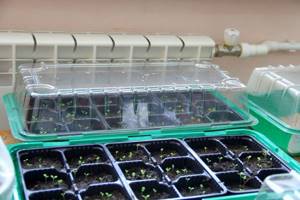
It is very convenient to germinate seeds in mini-greenhouses
How to grow garden lingonberries in a pot
Lingonberries, which are compact in size, can be placed at home if desired - on the windowsill or on the balcony. But it is worth considering the difficulties that may arise:
- Lingonberries have a horizontal and creeping rhizome, which will be cramped in small volumes;
- You will have to strictly control watering, since overdrying and waterlogging of the soil can destroy the plant.
You only need to water lingonberries with rainwater or water that has settled for several days at room temperature.
For planting you need to prepare:
- low but wide flowerpot. The size will depend on the root system of the lingonberry bush. There must be holes at the bottom to allow excess water to drain into the pan;
- drainage is a must;
- substrate - it is better to prepare it yourself. Regular garden or all-purpose soil will not work. The simplest mixture can be obtained by mixing 3 parts of high-moor peat and 1 part of coarse sand;
- planting material. You can buy it at a garden center or dig it up in the forest.
Step by step process:
- Place a good layer of drainage at the bottom of the flowerpot.
- Sprinkle the prepared soil mixture on top.
- Place the bush in the middle of the container and add remaining soil to the sides.
- Lightly compact the soil around the perimeter of the flowerpot and water generously. Be sure to remove any remaining water from the pan.
- Lingonberries should be kept in a bright place, but avoiding drafts. The plant feels very good outdoors. Therefore, if there is a balcony or loggia, you should move the flowerpot there.
Lingonberries in a flowerpot will become a real decoration for a balcony or window sill. Glossy green foliage, which does not fall off even in winter, will delight the eye throughout the year. Blooming lingonberries will allow you to admire miniature flowers collected in tassel bouquets. And ripened coral-red fruits will not only enliven the greens, but will also help diversify the taste sensations if you add them to prepared dishes.
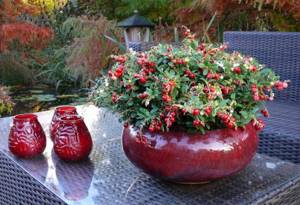
Lingonberries grown in a flowerpot will become a real decoration for a window sill or balcony.
Cranberries or lingonberries: which is healthier?
- Both red berries come from the swamp and are rich in vitamin C and many similar substances. Fruit drinks made from them are used during hot weather and to combat elevated temperatures. The sour taste perfectly relieves thirst.
- The berries are low in calories, but the taste varies. The indications and contraindications for the berries are similar, but lingonberry leaves have a more pronounced therapeutic effect and, accordingly, the presence of contraindications.
- The benefits of both berries are best preserved in raw and frozen form. Although jam, compotes and sauces are tasty, their benefits are minimal.
To freeze in the freezer, lingonberries and cranberries are sorted, washed and thoroughly dried on a towel. A wet berry will freeze into a lump and may crack when defrosted, but a dry one will be stored scattered without losing its properties.
Frozen berries can be poured into containers or distributed into bags, closed and stored for a year.
Peculiarities of growing lingonberries in different regions
Lingonberry is a fairly flexible plant that tolerates frost and increased temperatures well, but only with proper care. The difference between growing this crop in different regions is that in hot and average climates, lingonberries do not require shelter, as they easily adapt. In northern regions, varieties with an early flowering period may be threatened by spring frosts. Therefore, before the onset of stable warm weather, the bushes need to be covered with non-woven material.
Growing lingonberries in Ukraine
Lingonberries are not popular in Ukraine. Almost no one grows it. It is possible to meet this plant in nature only in the foothills of the Carpathians, where coniferous forests begin. But varieties adapted to the conditions of the local climate can be cultivated on plots.
A feature of growing lingonberries in Ukraine, especially in its southern regions, is frequent watering. If the air humidity is less than 50%, then the plant will have to be watered almost daily. Otherwise, planting and care are very similar to the same techniques that are carried out in other regions.
Contraindications to the use of lingonberries
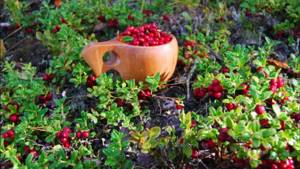
Lingonberry leaves contain tannins, which may not be beneficial, but on the contrary, harm people with kidney disease.
People with hypotension should not use lingonberry because it quickly lowers blood pressure.
If there is cholecystitis, then it is better for the patient to refrain from eating lingonberries. It is also contraindicated in people with hypersensitivity.

